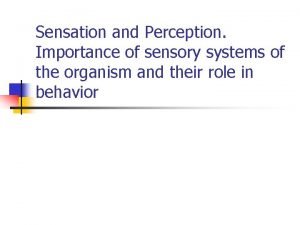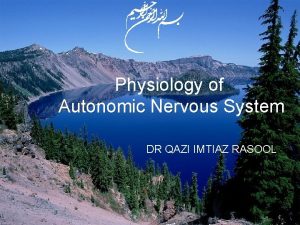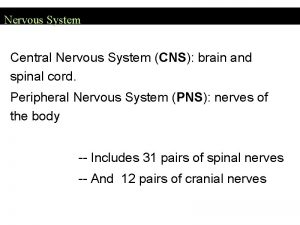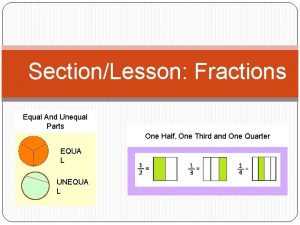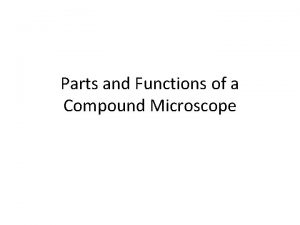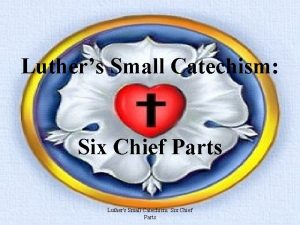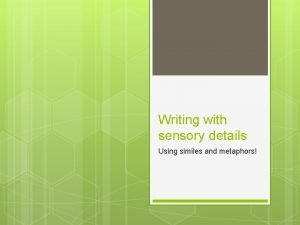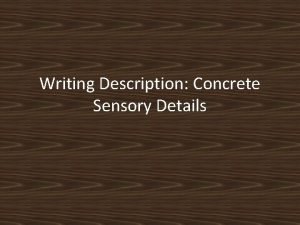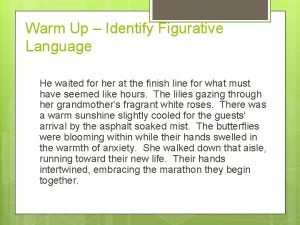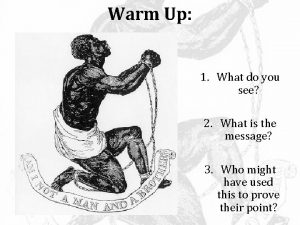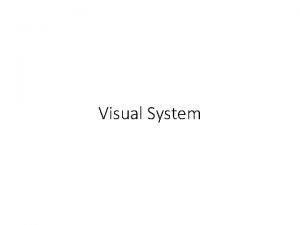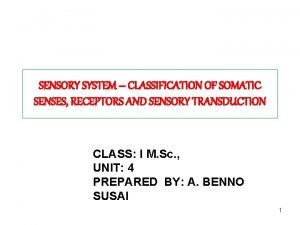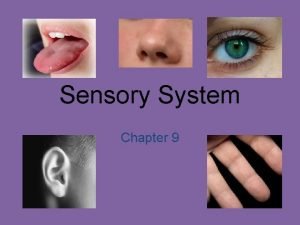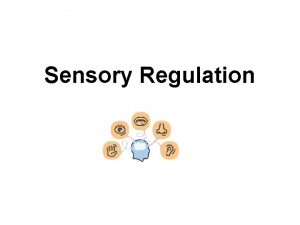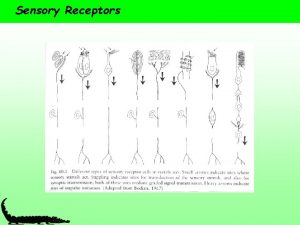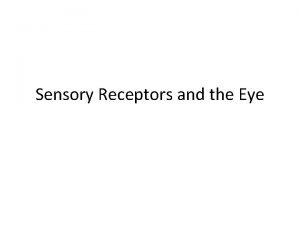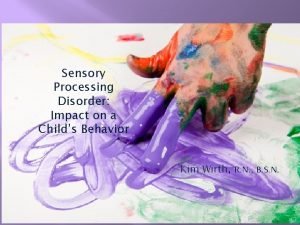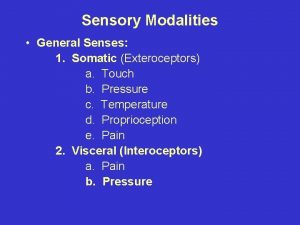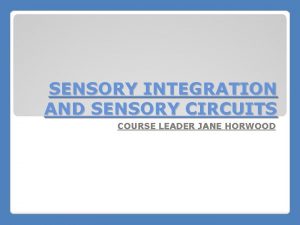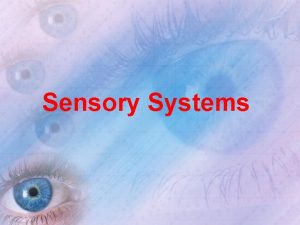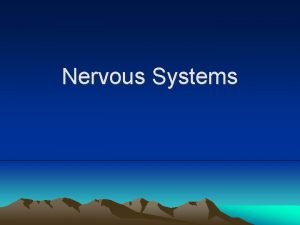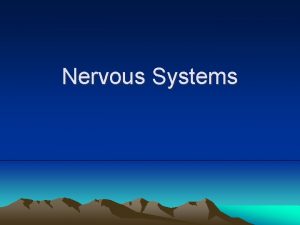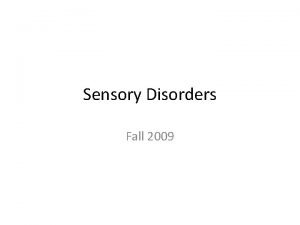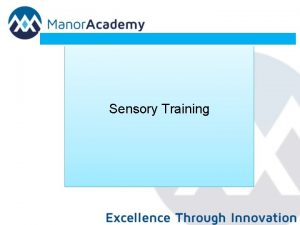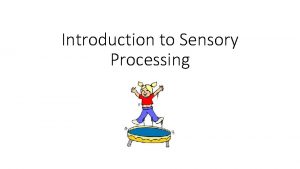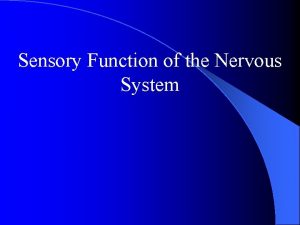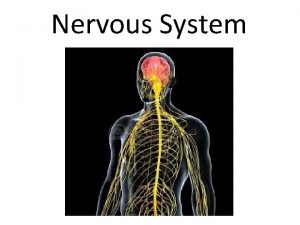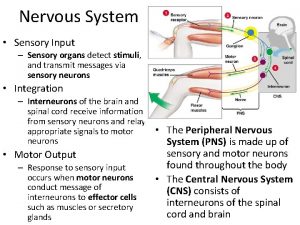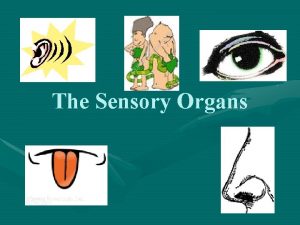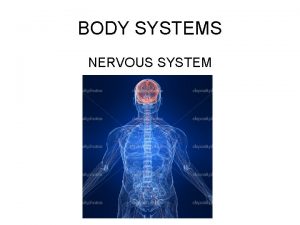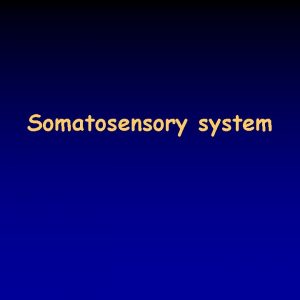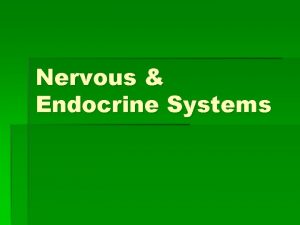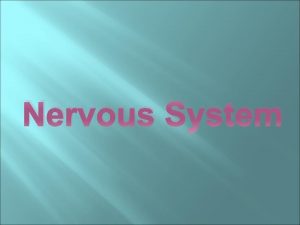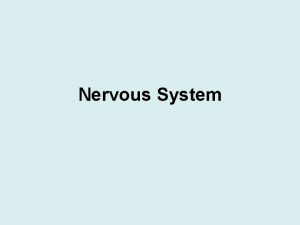Nervous Sensory systems Ch 38 2 parts of







































- Slides: 39

Nervous & Sensory systems Ch 38

2 parts of Nervous System Ø CNS = Brain and main nerve cords Ø PNS = paired cranial and spinal nerves

Peripheral Nervous System Ø Somatic nerves l l Motor functions Skeletal muscle voluntary (Shown in green) Ø Autonomic nerves l l Visceral functions smooth & cardiac muscle involuntary (Shown in red)

Fig. 34 -4, p. 575

Two Types of Autonomic Nerves Ø Sympathetic Ø Parasympathetic Ø Most organs receive input from both Ø Usually have opposite effects on organ

Sympathetic Nerves Ø Promote responses that prepare the body for stress or physical activity (fight-or-flight response) Ø Adrenaline secretion = increase heart rate, glucose released into blood, slow down of housekeeping activities

Parasympathetic Nerves Ø Promote housekeeping responses such as digestion Ø Lower heart rate Ø Glucose uptake

Communication Lines Stimulus (input) Receptors (sensory neurons) Integrators (interneurons) motor neurons Effectors (muscles, glands) Figure 34. 5 Page 575 Response (output)

Brains…. . Ø A. Most simple = cerebral ganglia Ø collection of nerves near head Ø B. Vertebrate brains Ø 1. gray matter: neuron cell bodies, non myelinated axons & glia Ø 2. white matter: axons covered in myelin Ø 3. cerebrospinal fluid fills ventricles in brain Ø a. filtered from arteries returned to veins Ø b. supplies nutrients/ carries hormones, removes waste

4. Neuroglia cells Ø astrocytes – provide support, direct formation of blood-brain barrier (tight junctions) Ø Oligodendrocytes – make myelin

5. Regions of the Brain Ø A. Brain Stem: conducts signals from spinal cord to brain, controls homeostasis Ø (breathing, heart rate, sleep) Ø 1. Hind Brain Ø a. medulla oblongata Ø b. Pons Ø 2. Mid Brain (hearing)

Ø B. Cerebellum – part of hind brain Ø 1. balance Ø 2. motor skills Ø 3. hand-eye coordination

Ø C. Thalamus – sensory info Ø D. Hypothalamus – homeostasis Ø heat Ø hunger/thirst Ø hormones Ø E. Cerebrum – Ø information processing

Function of the Spinal Cord Ø Expressway for signals btwn brain & peripheral nerves Ø Sensory & motor neurons make direct reflex connections in the spinal cord Ø Spinal reflexes do not involve the brain

Reflexes Ø Automatic movements in response to stimuli Ø Reflex arcs: sensory neurons synapse directly on motor neurons Ø (skip integrators)

Stretch Reflex STIMULUS Biceps stretches. sensory neuron motor neuron Response Biceps contracts. Figure 34. 16 Page 585



Assessing a Stimulus Ø Action potentials don’t vary in amplitude Ø Brain tells nature of stimulus by: Ø 1) Particular pathway that carries the signal Ø 2) Frequency of action potentials (how quickly is signal repeated) Ø 3) Number of receptors signalling

Taste Ø Chemoreceptors Ø Five primary sensations: l sweet, sour, salty, bitter, and umami Figure 35. 8 Page 604

Smell Ø Olfactory receptors Ø Receptor axons lead to olfactory lobe Ø Binding molecules triggers action potential olfactory bulb receptor cell Figure 35. 7 Page 604

Anatomy of Human Ear stirrup anvil auditory nerve hammer auditory canal eardrum cochlea Fig. 35. 11 a Page 614

Sound Reception Ø Sound waves make the eardrum vibrate Ø Vibrations are transmitted to the bones of the middle ear Ø The stirrup transmits force to the oval window of the fluid-filled cochlea

Sound Reception Ø Movement of oval window causes waves in the fluid inside cochlear ducts oval window (behind stirrup) eardrum round window Figure 35. 11 c Page 606 scala vestibuli scala tympani

scala vestibuli cochlear duct organ of Corti sensory neurons (to the auditory nerve) scala tympani Fig. 35 -11 d, p. 607

Sound Reception hair cells in organ of Corti basilar membrane tectorial membrane lumen of cochlear duct lumen of scala tympani to auditory nerve Figure 35. 11 e Page 607

Fig. 35 -12 a, p. 607

Vision Ø Sensitivity to light does not equal vision Ø Vision requires two components l Eyes l Capacity for image formation in the brain

Invertebrate Eyes Limpet ocellus ommatidium cuticle epidermis lens Compound eye of a deerfly sensory neuron Land snail eye Figures 35. 13 & 35. 14 Pages 608 & 609

vitreous body lens cornea retina optic tract Fig. 35 -15, p. 609

Human Eye sclera retina choroid iris lens pupil cornea aqueous humor fovea optic disk part of optic nerve ciliary muscle vitreous body Figure 35. 17 Page 610

Organization of Retina Ø Photoreceptors lie at the back of the retina, in front of a pigmented epithelium Ø For light to reach the photoreceptors, it must pass layers of neurons involved in visual processing

Organization of Retina Ø Signals from photoreceptors are passed to bipolar sensory neurons, then to ganglion cells Figure 35. 20 Page 612


Ø Reference: Ø http: //www. bio. davidson. edu/people/midor cas/animalphysiology/websites/2003/Mulle r/development%20 of%20 the%20 cephalop od%20 eye. htm Ø video Ø https: //vimeo. com/23085747

a Light rays from an object converge on the retina, form an inverted, reversed image. muscle contracted b When a ciliary muscle contracts, the lens bulges, bending the light rays from a close object so that they become focused on the retina. close object slack fibers muscle relaxed c When the muscle relaxes, the lens flattens, focusing light rays from a distant object on the retina. distant object taut fibers Fig. 35 -18, p. 611

cone cell stacked, pigmented membrane rod cell Fig. 35 -19, p. 612

The Photoreceptors Ø Rods l l Contain the pigment rhodopsin Detect very dim light, changes in light intensity Ø Cones l Three kinds; detect red, blue, or green l Provide color sense and daytime vision

Retina to Brain optic retina nerve lateral geniculate nucleus visual cortex Figure 35. 23 Page 613
 Neural circuits the organization of neuronal pools
Neural circuits the organization of neuronal pools Fundamentals of the nervous system and nervous tissue
Fundamentals of the nervous system and nervous tissue Neuronal pools are collections of
Neuronal pools are collections of Sensory systems
Sensory systems Chapter 14 skeletal muscular and nervous systems
Chapter 14 skeletal muscular and nervous systems Module 10 the nervous and endocrine systems
Module 10 the nervous and endocrine systems Prevertebral ganglia
Prevertebral ganglia Nervous system flow chart
Nervous system flow chart Nervous interactions with other systems
Nervous interactions with other systems Components of nervous system
Components of nervous system Central nervous system diagram
Central nervous system diagram Label the parts of the main divisions of the nervous system
Label the parts of the main divisions of the nervous system Decision support systems and intelligent systems
Decision support systems and intelligent systems Principles of complex systems for systems engineering
Principles of complex systems for systems engineering Embedded systems vs cyber physical systems
Embedded systems vs cyber physical systems Elegant systems
Elegant systems Which of the following is optional in a friendly letter?
Which of the following is optional in a friendly letter? Equal parts and unequal parts
Equal parts and unequal parts Body tube microscope
Body tube microscope 6 chief parts of luther's small catechism
6 chief parts of luther's small catechism Sensory metaphors
Sensory metaphors 11 sentence paragraph format
11 sentence paragraph format Concrete writing definition
Concrete writing definition Sensory ethnography
Sensory ethnography What does sensory language mean
What does sensory language mean Sensory figure of harriet tubman
Sensory figure of harriet tubman Anatomy of visual system
Anatomy of visual system Recognizing imagery
Recognizing imagery Structure of the sensory system
Structure of the sensory system Types of sensory receptors
Types of sensory receptors Sensory system organs
Sensory system organs Sensory cup analogy
Sensory cup analogy Classification of sensory receptors
Classification of sensory receptors Classification of sensory receptors
Classification of sensory receptors Sensory receptors in eye
Sensory receptors in eye Sensory processing disorder dsm
Sensory processing disorder dsm Tina champagne sensory modulation
Tina champagne sensory modulation Classification of sensory receptors
Classification of sensory receptors Sensory symptoms
Sensory symptoms Types of sensory disorders
Types of sensory disorders



